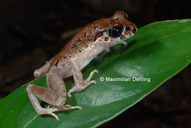|
Leptobrachella picta (Malkmus, 1992)
Painted Slender Litter Frog (Haas, Das & Hertwig 2024) | family: Megophryidae subfamily: Leptobrachiinae genus: Leptobrachella |
| Species Description: Malkmus, R. 1992. Leptolalax pictus sp. n. (Anura: Pelobatidae) vom Mount Kinabalu/Nord-Borneo. Sauria. Berlin 14: 3–6. | |
|
Etymology: The species epithet, "picta," is the female Latin word for "painted." |
|
 © 2009 Maximilian Dehling (1 of 3) |
|
|
|
Description Juveniles in particular might be confused with L. sabahmontana, which appears to also occur sympatrically (compare Inger et al. 2017). The latter species however, is smaller in adults and shows a speckled venter, which is completely white in L. picta (Matsui et al. 2014). Dorsally light brown, with dark brown markings (which are light-edged). These markings also form an irregular band from the eye to the groin. Uniformly white or cream venter. The skin is smooth and the toes are slightly webbed at the base (Inger et al. 2017, Haas et al. 2024). Distribution and Habitat Country distribution from AmphibiaWeb's database: Malaysia Malaysian region distribution from AmphibiaWeb's database: Sabah
Life History, Abundance, Activity, and Special Behaviors Males call at night from low vegetation, 20-150cm above ground. The call series of around 30 notes last between 1,9 and 4,9 sec. followed by breaks of 4 - 5 sec. A single note lasts 62 ms and shows a decreasing modulation from 7160 to 6800 Hz (Malkmus and Riede 1993). Larva Trends and Threats At least 50% of L. picta individuals can be found in protected areas, such as: Crocker Range and Kinabalu National Parks (Sabah), Kayan Mentarang National Park (Kalimantan), and Ulu Temburong National Park (Brunei) (IUCN 2018). Possible reasons for amphibian decline General habitat alteration and loss References Haas A., Das I., and Hertwig S.T. (2024). Leptobrachella pictus Painted Slender Litter Frog. Frogs of Borneo – The frogs of East Malaysia and their larval forms. Electronic Database accessible at https://www.frogsofborneo.org/frogs/megophryidae/leptobrachella/pictus. Accessed on 16 December 2024. Inger, R. F., Stuebing, R. B., Grafe, U., and Dehling, J. M. (2017). A Field Guide to the Frogs of Borneo. Natural History Publications (Borneo) Limited, Kota Kinabalu. IUCN SSC Amphibian Specialist Group. (2018). Leptobrachella picta. The IUCN Red List of Threatened Species 2018: e.T57573A114918465. https://dx.doi.org/10.2305/IUCN.UK.2018-1.RLTS.T57573A114918465.en. Accessed on 18 December 2024. Malkmus, R. and Riede, K. (1993). Nachtrag zu Leptolalax pictus MALKMUS, 1992 (Anura: Pelobatidae). SAURIA, 15(3), 7-9. [link] Matsui, M., Nishikawa, K., and Yambun, P. (2014). A new Leptolalax from the mountains of Sabah, Borneo (Amphibia, Anura, Megophryidae). Zootaxa, 3753(3), 440-452. [link]
Originally submitted by: Frederic Griesbaum (2024-12-18) Description by: Frederic Griesbaum (updated 2024-12-18)
Distribution by: Frederic Griesbaum, Ann T. Chang (updated 2024-12-18)
Life history by: Frederic Griesbaum (updated 2024-12-18)
Larva by: Frederic Griesbaum (updated 2024-12-18)
Trends and threats by: Ann T. Chang (updated 2024-12-18)
Edited by: Ann T. Chang (2024-12-18) Species Account Citation: AmphibiaWeb 2024 Leptobrachella picta: Painted Slender Litter Frog (Haas <https://amphibiaweb.org/species/5651> University of California, Berkeley, CA, USA. Accessed Jun 15, 2025.
Feedback or comments about this page.
Citation: AmphibiaWeb. 2025. <https://amphibiaweb.org> University of California, Berkeley, CA, USA. Accessed 15 Jun 2025. AmphibiaWeb's policy on data use. |



 Map of Life
Map of Life